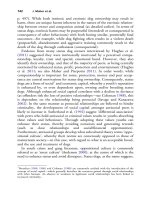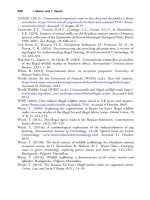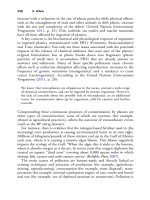The palgrave international handbook of a 262
Bạn đang xem bản rút gọn của tài liệu. Xem và tải ngay bản đầy đủ của tài liệu tại đây (25.79 KB, 1 trang )
258
R. White
increase with a reduction in the size of plastic particles while physical effects,
such as the entanglement of seals and other animals in drift plastic, increase
with the size and complexity of the debris’ (United Nations Environment
Programme 2011, p. 25). Fish, seabirds, sea turtles and marine mammals
have all been affected by ingestion of plastics.
A key concern is the biochemical and physiological response of organisms
to ingested plastics contaminated with PBTs (Persistent, Bioaccumulative
and Toxic chemicals). Not only are there issues associated with the potential
impacts of the releases of chemical additives that were part of the plastics’
original formulation, but as plastic breaks down into fragments (plastic
particles of small size), it accumulates PBTs that are already present in
seawater and sediments. Many of these specific pollutants cause chronic
effects such as endocrine disruption affecting reproduction, increases in the
frequency of genetic mutations (mutagenicity) and a tendency to cause
cancer (carcinogeniticy). According to the United Nations Environment
Programme (2011, p. 28):
We know that microplastics are ubiquitous in the ocean, contain a wide range
of chemical contaminants, and can be ingested by marine organisms. However,
the lack of certainly about the possible role of microplastics, as an additional
vector for contaminants taken up by organisms, calls for caution and further
research.
Compounding these continuous processes of contamination by plastics are
other types of contamination, some of which are systemic (for example,
related to agricultural practices), others the outcome of extraordinary events
(such as the BP oilrig disaster).
For instance, there is evidence that the nitrogen-based fertiliser used in (the
increasing) corn production is causing environmental harm in its own right.
Millions of kilograms/pounds of those nitrates end up in the Gulf of Mexico
each year, where it is causing a massive algae bloom. This bloom negatively
impacts the ecology of the Gulf: ‘When the algae dies it sinks to the bottom,
where it absorbs oxygen as it decays. In recent years that oxygen depletion has
created an aquatic “dead zone” covering about 8,000 square miles in which
shrimp, fish, oysters and crabs cannot survive’ (Reliable Plant 2007).
The main causes of pollution are human-made and directly linked to
existing techniques and processes of production (for example, agriculture,
mining, manufacturing), consumption (for example, waste disposal), transportation (for example, internal combustion engine of cars, trucks and buses)
and war (for example, use of depleted uranium in armaments). Pollution is









